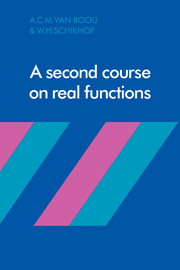Introduction
Published online by Cambridge University Press: 06 January 2010
Summary
With this introduction (to Sections 1–15) we try to achieve several goals. Not only do we hope that it will give the reader an impression of the kind of problems that are treated in the sequel but, in addition, it includes the program that will be followed throughout Sections 1–15. With this program in mind the reader should find that at each stage the theory provides answers to questions that have come about in a natural way.
In the introduction we make an actual start with the theory, so in this sense it is an ordinary section, not to be disregarded by the reader.
The starting point
Throughout the introduction by a, function we mean a real valued function defined on the closed unit interval [0, 1].
Let us first collect a few results known from elementary courses on analysis and calculus. We have:
A monotone function is Riemann integrable.
A continuous function is Riemann integrable.
A differentiable function is continuous.
A continuous function has an antiderivative.
Less common is the notion of Darboux continuity (sometimes called the intermediate value property), so we explain it here.
DEFINITION. A function ƒ is Darboux continuous if for all p, q ∈ [0, 1] and for each c between ƒ(p) and ƒ(g) there is an x between p and q such that ƒ(x) = c.
(A real number s is said to lie between the real numbers t and u if either t ≤ s ≤ u or u ≤ s ≤ t.)
- Type
- Chapter
- Information
- A Second Course on Real Functions , pp. 1 - 8Publisher: Cambridge University PressPrint publication year: 1982



